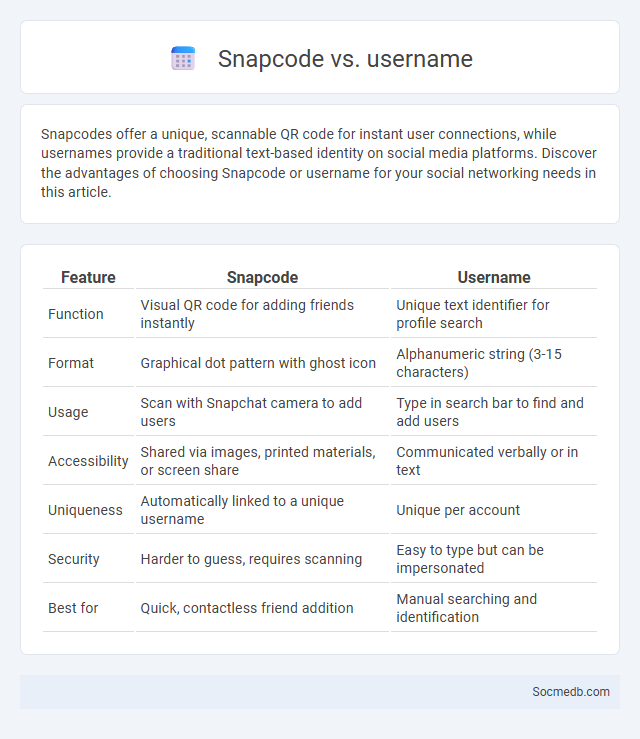
Photo illustration: Snapcode vs username
Snapcodes offer a unique, scannable QR code for instant user connections, while usernames provide a traditional text-based identity on social media platforms. Discover the advantages of choosing Snapcode or username for your social networking needs in this article.
Table of Comparison
| Feature | Snapcode | Username |
|---|---|---|
| Function | Visual QR code for adding friends instantly | Unique text identifier for profile search |
| Format | Graphical dot pattern with ghost icon | Alphanumeric string (3-15 characters) |
| Usage | Scan with Snapchat camera to add users | Type in search bar to find and add users |
| Accessibility | Shared via images, printed materials, or screen share | Communicated verbally or in text |
| Uniqueness | Automatically linked to a unique username | Unique per account |
| Security | Harder to guess, requires scanning | Easy to type but can be impersonated |
| Best for | Quick, contactless friend addition | Manual searching and identification |
Introduction to Snapchat Identification Methods
Snapchat identification methods utilize unique identifiers such as usernames, Snapcodes, and linked phone numbers to verify user identities securely. These tools enable users to find friends and protect personal information through two-factor authentication and temporary access codes. Understanding how your Snapchat ID works enhances account security and streamlines social interactions on the platform.
What is a Snapcode?
A Snapcode is a unique, scannable QR code created by Snapchat that allows users to quickly add friends, unlock filters, or access exclusive content within the app. Each Snapcode contains a distinct pattern and avatar, making it easily recognizable and personalized for individual users or brands. This functionality enhances user engagement by simplifying connections and promoting interactive experiences on the Snapchat platform.
Understanding Snapchat Usernames
Snapchat usernames serve as unique identifiers that differentiate users within the platform's vast network, allowing seamless connection and communication. These usernames must be distinct, often combining letters, numbers, or underscores to ensure availability while maintaining personal branding or anonymity. Understanding how to create, modify, and share Snapchat usernames is essential for enhancing user engagement and expanding social media presence.
Key Differences: Snapcode vs Username
Snapcode and username serve distinct functions on Snapchat, with Snapcode being a unique QR-like code that allows instant adding of friends by scanning, while usernames are custom text identifiers used for manual searching and direct messaging. Snapcodes enhance user convenience by enabling quick connections without typing, whereas usernames provide a personalized and memorable identity within the app. Understanding the key differences between Snapcode and username is crucial for optimizing friend discovery and communication on Snapchat.
Advantages of Using Snapcodes
Snapcodes offer a streamlined method for quickly adding friends and accessing exclusive content on Snapchat by simply scanning a unique QR code. This feature boosts user engagement by simplifying connections and enhancing the sharing experience through easily accessible profiles and filters. Brands leverage Snapcodes to increase visibility and drive targeted traffic, making it a powerful tool for marketing campaigns and user acquisition.
Benefits of Adding via Username
Adding connections via username on social media enhances your networking by enabling precise and instant friend or follower identification. This method reduces errors compared to searching by real names, improving your experience while expanding relevant contacts. Your social media growth becomes more efficient as usernames provide a unique, direct link to individual profiles.
Privacy Concerns: Snapcode vs Username
Snapcodes provide a unique, scannable code that enables fast friend additions without revealing your username, enhancing your privacy by limiting exposure to unwanted contacts. Usernames, while recognizable and easy to share, are susceptible to being searched publicly, increasing the risk of privacy breaches and unsolicited interactions. You can protect your social media presence more effectively by using Snapcodes for connections instead of publicly sharing your username.
Ease of Use: Which is Simpler?
Social media platforms like Instagram and Twitter offer intuitive interfaces designed for effortless navigation. Instagram's visual-based layout simplifies content creation and browsing through images and stories, making it ideal for users who prefer quick, engaging posts. Twitter's streamlined feed emphasizes short text updates, providing a straightforward experience for real-time news and conversations without overwhelming features.
Best Practices for Sharing Your Snapchat
Best practices for sharing your Snapchat focus on maintaining privacy by carefully selecting your audience and enabling Snapchat's custom privacy settings. Use engaging content like behind-the-scenes snaps, stories, and interactive filters to boost Your visibility and connect authentically with followers. Consistent posting during peak hours and using relevant hashtags enhance discoverability and audience growth on the platform.
Conclusion: Choosing the Right Method
Selecting the right social media strategy depends on understanding your target audience, business goals, and available resources. Analyzing engagement metrics and content performance helps tailor your approach for maximum impact. Your success hinges on continuously adapting methods to align with evolving trends and user preferences.
 socmedb.com
socmedb.com